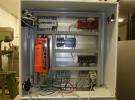Hi,
I’m using LabJack T7:
Hardware Version: 1.35
Firmware Version: 1.0287
Bootloader Version: 0.96
Recovery Firmware Version: 0.6606
I would like to be able to stream in (at least 7 channels) and out simultaneously at high scan rates (at least 5000 – 10000 per channel). Also, I would like to stream out specific signals read from a file.
I’m using Python to write an application to do that. Thanks to the examples attached in Python_LJM_2019_04_03 library, I was able to stream in multiple channels at high scan rates. I was also able to load a signal from a file to an out buffer and stream it out, by modifying in_stream_with_non_looping_out_stream.py example. However, when I update the buffer out in the way, as in the example, I am only able to stream with lower scan rates. For streaming in 3 analog channels (with one stream out channel= FIO_STATE), I can’t get more than 2000 scan rate. When I want to add more stream in channels or core timer to my stream in, the possible, stable scan rate gets even lower and the LJM buffer overflows very fast (the device buffer is being cleared nicely). I was hoping that you could either take a look at my code and tell me what might be preventing me from getting higher scan rates, or suggest another way to update the buffer to stream out the data read from the file… That is, if that is why I am not able to stream at higher scan rates.
Description of my code:
My application is run from forum_test_t7 file. It allows to select in and out channels, scan rate and size of the out buffer. The stream will stop after clicking Ctrl+c. The StreamT7 class is responsible for continuously calling ljm.eStreamRead(handle) to read the stream, and logging. device_t7 file, is a modified ljm_stream_util.py example, where I changed create_out_context function to my own create_out_context_from_file, and added my configure_stream function to configure the stream in and out.
The testing version is hard coded to only stream in analog channels and use FIO0 and FIO3 as stream out channels.
Attachments:
my_waveform.txt – file with digital signal to stream out (to run it with the app, convert to csv)
forum_test_t7.py – test file that starts the stream (change INPUTS, SCAN_FREQUENCY,OUT_BUFFER_SIZE)
device_t7.py – file with functions that define how to update out buffer and how to configure stream
StreamT7 – class to create object that repeatedly calls ljm.eStreamRead
+example log files



.png%3Fitok=PHGBxf6M)


.jpg%3Fitok=B1YcuDFK)
.png%3Fitok=Ybt-OlgU)
Stream-out will typically only achieve the same maximum sampling rates as in-stream when you loop over a set number of samples; there is a typical communication overhead of around 0.6ms per modbus packet sent to the device from a host computer over USB and this can significantly limit your sample rate if you are dynamically sending updates for your waveform. During our testing, we have found similar limits of around 2000-3000Sa/s using the in_stream_with_non_looping_out_stream examples.
We recently created some functions in LJM (currently in beta) that help make stream-out easier and the AperiodicStreamOut functions work with faster stream rates. During testing, we observed stable stream-out waveforms at up to around 10,000Sa/s.
You can find the beta LJM install here:
https://labjack.com/support/software/installers/ljm
We have Python examples on our Github page that include these new functions (note that you will need to rebuild ljm-python from source since the Python wrapper was updated to include the new functions). I would recommend reading all of your data from file and bulk loading it with the WriteAperiodicStreamOut function before starting stream. The new functions have their own thread for doing work, so that should fix any issues with eStreamRead you are having due to streaming out:
https://github.com/labjack/labjack-ljm-python
Thank you for your fast response. I will try the new library version to see if I can get faster stream rates with that.
Hi,
I upgraded to beta LJM and I did some tests of aperiodic stream out. The speeds look great and very stable, and the buffer is not overflowing! However, I’m having hard times trying to understand how WriteAperiodicStreamOut works. In the example (stream_in_with_aperiodic_stream_out.py), the function is being called before I start the stream, and then cyclically, before every eStreamRead. It is regularly updating buffer with constant number (i.e. 512 samples, of the same values (increasing from 0 to 2.5)
1) When I stream-in two channels at the same time at i.e. 5000 scan rate, I am getting 2500 samples per channel. What are the values for streamed-out signal above 512 sample? Is it last read value that is being replicated until the next read from the buffer? (cyclical_increase_of_voltage.png)
2) The documentation (https://labjack.com/support/software/api/ljm/function-reference/stream-f...) mentions that buffer out max size is being allocated automatically. You recommended to load the WriteAperiodicStreamOut function with a file content before starting the stream. However, my files might often be longer than max number of samples the out buffer can hold, and I will have to update it. How can I do that? How often?
3) Also, I don’t fully understand the sleep time calculation between every eStreamRead. It is calculated based on the user defined number of writes to the buffer. What if I want to stream for undefined amount of time (until user stops the stream)?
4) Lastly, and unfortunately, my streamed-out signal does not look like the signal from the file at all…(streamed_out_sine.png) I tried to load WriteAperiodicStreamOut function with sequential data chunks from the file before every eStreamRead, but this does not seem to work. As a benchmark, I am streaming in a sine wave, to check if I am not losing any data. And that signal looks perfect. I would be really grateful if you could tell me what am I doing wrong. I attached my updated code.
I configure the stream within configure_stream function in device_t7_aperiodic.py, and call eStreamRead in read_stream function that is StreamT7_aperiodic class method. forum_test_t7_aperiodic.py is a test file
Attachments:
my_sine_wave.csv – file with signal to stream out
forum_test_t7_aperiodic.py – test file that starts the stream
device_t7_aperiodic.py – file with functions that define how to configure stream
StreamT7_aperiodic – class to create an object that repeatedly calls ljm.eStreamRead
+examples of streamed signal that was plotted afterwards (top channel is stream-in of sine wave, bottom channel is the signal read from a file and streamed-out using WriteAperiodicStreamOut)
https://labjack.com/support/software/api/ljm/function-reference/LJMWrite...
https://labjack.com/support/software/api/ljm/streaming-lots-of-9999-values
https://labjack.com/support/software/api/ljm/constants/ljmstreamscansreturn
Thank you for your detailed explanation. It really helped me better understand how WriteAperiodicStreamOut works. And I had no idea that it is possible to modify LJM stream out buffer size! So, thank you for telling me how to do that.
Now, with that knowledge, all I needed to do with my code, was:
-> increase LJM buffer out size as needed,
-> upload a whole file to WriteAperiodicStreamOut once (!) before I start the stream,
-> set a reasonable number of scansPerRead (I went with 1000),
-> and remove the unnecessary sleep time from my code.
That solved all my issues. The stream speeds are fantastic! I got 20,000Sa/sec while simultaneously streaming in 3 analog channels and streaming out digital FIO_STATE. Which I believe, is as good as speeds for stream in only.Without any buffer overflows or data loss. All beautiful and stable. Thank you for that simple and brilliant solution for stream out.
I am looking for someone to assist with a project I have using T7 streaming several channels of data and generating operator interface to display various operator screens. If interested please contact [email protected]